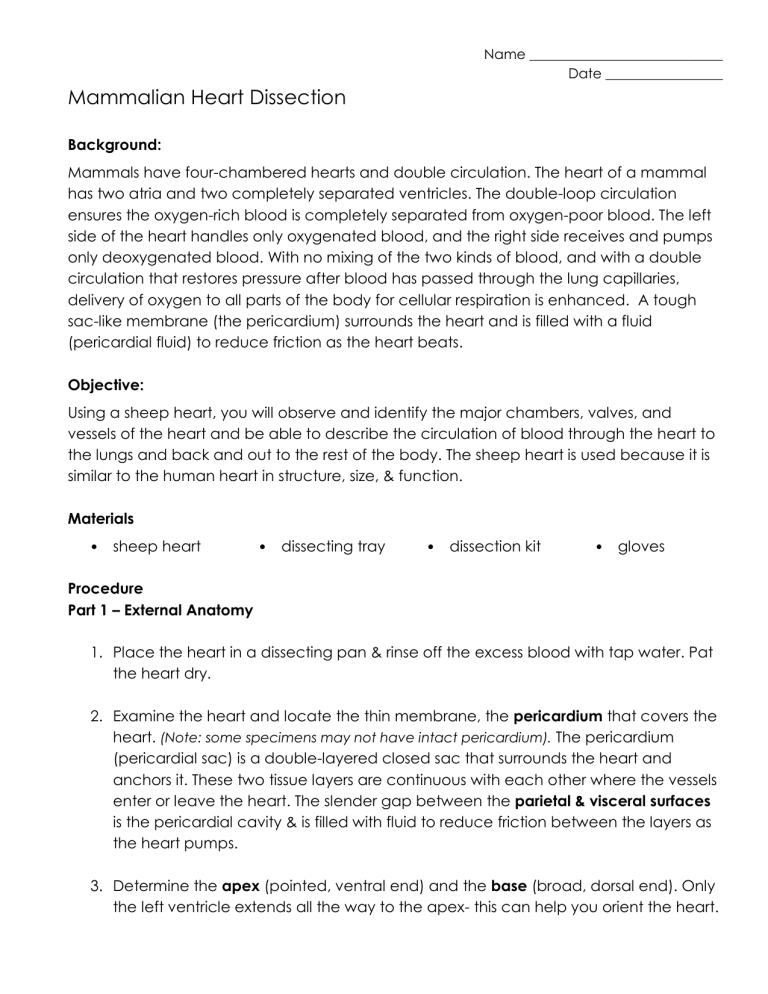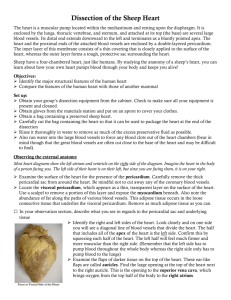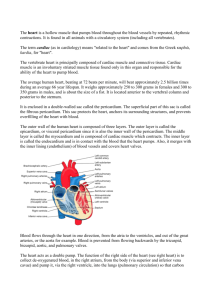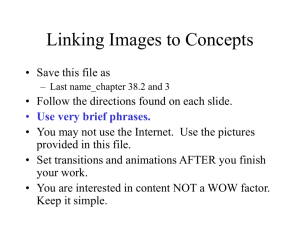Name Date Mammalian Heart Dissection Background: Mammals

Name ____________________________
Date _________________
Mammalian Heart Dissection
Background:
Mammals have four-chambered hearts and double circulation. The heart of a mammal has two atria and two completely separated ventricles. The double-loop circulation ensures the oxygen-rich blood is completely separated from oxygen-poor blood. The left side of the heart handles only oxygenated blood, and the right side receives and pumps only deoxygenated blood. With no mixing of the two kinds of blood, and with a double circulation that restores pressure after blood has passed through the lung capillaries, delivery of oxygen to all parts of the body for cellular respiration is enhanced. A tough sac-like membrane (the pericardium) surrounds the heart and is filled with a fluid
(pericardial fluid) to reduce friction as the heart beats.
Objective:
Using a sheep heart, you will observe and identify the major chambers, valves, and vessels of the heart and be able to describe the circulation of blood through the heart to the lungs and back and out to the rest of the body. The sheep heart is used because it is similar to the human heart in structure, size, & function.
Materials
• sheep heart
Procedure
• dissecting tray • dissection kit • gloves
Part 1 – External Anatomy
1.
Place the heart in a dissecting pan & rinse off the excess blood with tap water. Pat the heart dry.
2.
Examine the heart and locate the thin membrane, the pericardium that covers the heart. (Note: some specimens may not have intact pericardium). The pericardium
(pericardial sac) is a double-layered closed sac that surrounds the heart and anchors it. These two tissue layers are continuous with each other where the vessels enter or leave the heart. The slender gap between the parietal & visceral surfaces is the pericardial cavity & is filled with fluid to reduce friction between the layers as the heart pumps.
3.
Determine the apex (pointed, ventral end) and the base (broad, dorsal end). Only the left ventricle extends all the way to the apex- this can help you orient the heart.
4.
Make a slit in the pericardium near the apex and slide the heart out. Do not remove the pericardium off the base of the heart yet.
5.
At the base of the heart the pericardium blends with the coverings of the great vessels. The aorta and pulmonary artery are the two largest vessels. Both have thick rubbery white or gray walls. The aorta emerges from the center of the base of the heart. The pulmonary artery emerges from the right ventricle.
6.
The vena cava and the pulmonary veins are embedded within the fibrous tissue, but they are thinner walled and often collapsed, so are more difficult to see. The vena cava is a thin-walled, large diameter bluish or dark red tube entering the right atrium. You may see both the anterior and posterior vena cava, which will join before entering the right atrium. The pulmonary veins enter the left atrium. Use your fingers or a blunt probe in the vessels see where they lead to help you identify them
(be gentle so you do not break any valves). After identifying the great vessels, carefully remove the remainder of the pericardium from the base of the heart.
7.
Gently squeeze the heart and see if you can determine the left side from the right side. The left ventricle (which extends all the way to the apex) is thicker.
Question #1: Which ventricle pumps blood to the body?
8.
Place the heart in the dissecting pan so that the ventral (front) side is towards you with the major blood vessels on the top and the apex down. The heart is now in the pan in the position it would be in a body as you face the body. Locate the following chambers of the heart: a.
Left atria - upper chamber to your right b.
Left ventricle - lower chamber to your right c.
Right atria - upper chamber to your left d.
Right ventricle - lower chamber to your left
The atriums are wrinkled, dark red chambers with flap-like extensions called
auricles
9.
Relocate the great vessels at the base of the heart and make sure you had them identified correctly: a.
Pulmonary artery - branches & carries blood to the lungs to receive oxygen & can be found curving out of the right ventricle. b.
Aorta - located near the right atria & just behind the pulmonary arteries to the lungs. Locate the curved part of this vessel known as the aortic arch.
Attempt to identify the 3 main arteries off the aortic arch. (Refer to your notes if you need to!)
c.
Pulmonary veins - these vessels return oxygenated blood from the lungs to the left atrium (they may be hard to find!). d.
Inferior & superior vena cava - these two blood vessels are located on your left of the heart and connect to the right atrium. Deoxygenated blood from the body enters the heart through these vessels. Use your probe to feel down into the right atrium. These vessels do not contain valves where they enter the heart – blood flow is not restricted.
Question #2: How does the diameter of the vena cava compare to the diameter of the aorta? Which vessel has thicker walls? Can you make an inference about blood volume, pressure or velocity from your observations?
10.
Locate the coronary artery which lies in the whitish groove on the front of the heart.
It branches over the front & the back of the heart to supply oxygen & nutrients to the heart muscle itself. You may need to scrape away some fat to see it clearly.
IMPORTANT: At this point, check carefully to confirm that you have correctly identified the major vessels, R & L atria and R & L ventricles BEFORE you begin drawing. You will need to remember these for when we begin cutting.
Observations
1.
Prepare a formal drawing of the external anatomy of your heart in this position. a.
Title: External Mammalian Heart (Sheep) b.
Subtitle: Ventral View c.
You will need to determine the scale factor of your drawing (1x, 1.5x 2x?) d.
Labels all structures you identified in the lab!





